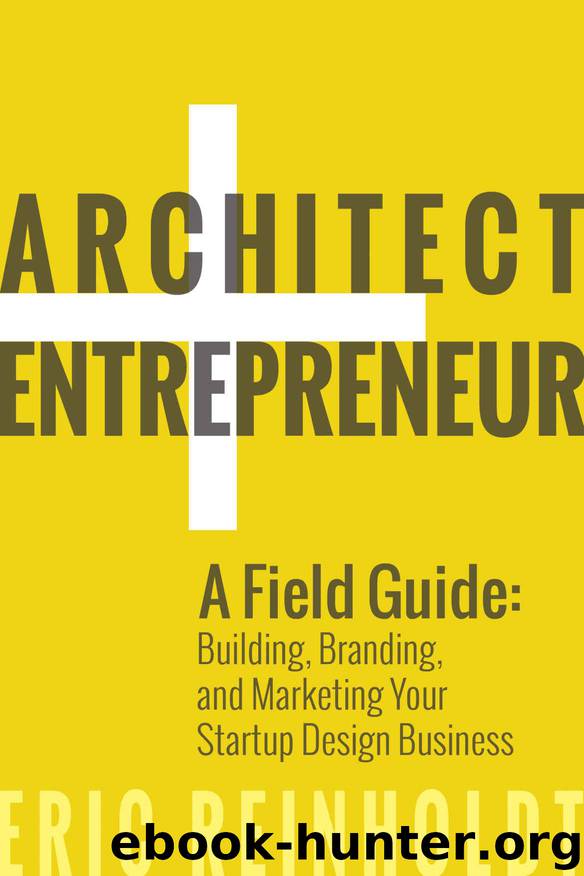Architect and Entrepreneur: A Field Guide to Building, Branding, and Marketing Your Startup Design Business by Reinholdt Eric

Author:Reinholdt, Eric [Reinholdt, Eric]
Language: eng
Format: azw, epub
Publisher: 30X40 Design Workshop Press
Published: 2015-04-08T16:00:00+00:00
Getting Hired
After the interview is over you’ll want to follow-up with the client. Develop one e-mail and save it as a template to use as the starting point for you correspondence (be sure to add this to your SOP). This way you’re not reinventing it each time, but you’ll still have room to personalize it and tailor it to each specific client.
If you’ve promised to follow-up on anything (fee proposal, references, etc.) tell the client when they can expect it from you. If there are any unanswered questions you had be sure to request answers to those as well.
I add my initial impressions, concerns and project specific information to the meeting notes I took right after the interview while it’s still fresh in my mind. I take a photo of this and file it in the corresponding ‘prospective client’ folder I maintain within Evernote. I also add any site photos if the meeting was held on-site.
Declining the Job (or saying “No, thanks.”)
One of your most important jobs as CEO is learning when to say no. After the interview you should have a fairly good sense for whether or not you’d accept the job if offered. When you’re just getting things up and running it’s easy to fall into the trap of accepting anything and everything that comes along, especially when you’re staring at empty boards and no revenue.
Revenue aside, you want to invest your time and business resources into projects that will become the foundation of your brand. The early projects are especially crucial in this regard.
Here’s a list of things to look out for and guide your decision to take on a project or let it pass you by:
Misaligned budgets. Refusing to accept average costs of design or construction in your area is a red flag for a client with unreasonable expectations.
Very small budgets. These can consume massive amounts of time and are often wed to picky clients.
Expectations. We can’t expect non-professionals to have a sense for all of the costs involved in construction, but if we offer professional advice and it’s readily dismissed it’s a warning sign that the client may have unrealistic expectations. Someone unwilling to accept your professional advice is a bad partner.
Communication Issues. If a client doesn’t respond to you in a timely manner you can bet that those patterns will extend to paying bills and other aspects of your professional relationship. Early patterns will be amplified under the stressful conditions of mounting design fees and escalating construction costs.
Is the project a good fit? Does the client’s vision align with yours? There’s no sense in designing a historical renovation if you’re pursuing modern, minimalist cottage designs. Make sure your brand mission will be represented in the final product. It’s a disservice to you and your client to do otherwise.
Is the person a good fit? Can you imagine spending time with this person? The project and client go hand in hand. You may love the project but find the client difficult. The two are inseparable; it takes both to make it a successful endeavor.
Download
Architect and Entrepreneur: A Field Guide to Building, Branding, and Marketing Your Startup Design Business by Reinholdt Eric.epub
This site does not store any files on its server. We only index and link to content provided by other sites. Please contact the content providers to delete copyright contents if any and email us, we'll remove relevant links or contents immediately.
Kathy Andrews Collection by Kathy Andrews(11706)
The remains of the day by Kazuo Ishiguro(8787)
Paper Towns by Green John(5061)
Spare by Prince Harry The Duke of Sussex(5052)
The Body: A Guide for Occupants by Bill Bryson(4950)
Industrial Automation from Scratch: A hands-on guide to using sensors, actuators, PLCs, HMIs, and SCADA to automate industrial processes by Olushola Akande(4910)
Machine Learning at Scale with H2O by Gregory Keys | David Whiting(4100)
Be in a Treehouse by Pete Nelson(3922)
Never by Ken Follett(3760)
Harry Potter and the Goblet Of Fire by J.K. Rowling(3758)
Goodbye Paradise(3709)
Into Thin Air by Jon Krakauer(3288)
The Remains of the Day by Kazuo Ishiguro(3279)
The Cellar by Natasha Preston(3241)
The Genius of Japanese Carpentry by Azby Brown(3208)
Fairy Tale by Stephen King(3192)
120 Days of Sodom by Marquis de Sade(3159)
The Man Who Died Twice by Richard Osman(2977)
Drawing Shortcuts: Developing Quick Drawing Skills Using Today's Technology by Leggitt Jim(2974)
